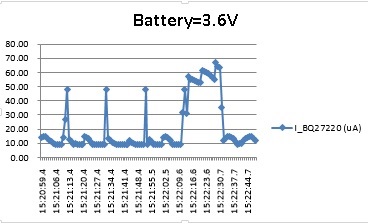Tool/software: Linux
Dear Experts,
How can I enter lowest power consumption of BQ27220?
I want to reduce power consumption of Battery that connected to BQ27220.
I got some information now.
1) The BQ27220 doesn’t support a shutdown command. The references to shutdown mode in the TRM ( SLUUBD4.pdf) are invalid. Thus we can only enter sleep mode. And BQ27220 will enter sleep mode automatically.
(-- Can TI update latest TRM for us? -- )
2) To enter lowest power consumption in sleep mode, set below configs, then the current will drop to approx. 9uA.
-) Configure the device for sleep mode (Operation Config A [SLEEP] = 1)
-) Set Dsg Relax Time to zero
-) Operation Config A [WAKE_EN, WK_TH0, WK_TH1] all zero
I had already set BQ27220 to
==============
0x922E nResult(0xFF00)
0x922E MACData(0X3e 0x3f) = 0x922E
0x922E MACData(0X40 0x41) = 0x0000 >> Set Dsg Relax Time to zero
==============
0x9206 nResult(0xFF00)
0x9206 MACData(0X3e 0x3f) = 0x9206
0x9206 MACData(0X40 0x41) = 0x8004 >> disable the wake comparator (Operation Config A [WAKE_EN, WK_TH0, WK_TH1] all zero)
==============
But FG current is still 15uA, and still can see much higher current draw happening every 20 seconds.
Anyone knows why FG current cannot down to 9uA??
and why did not disable wake-up evey 20 seconds??
Did I set wrong data memory position??
Here is our schematic related to BQ27220.
thanks
HB


